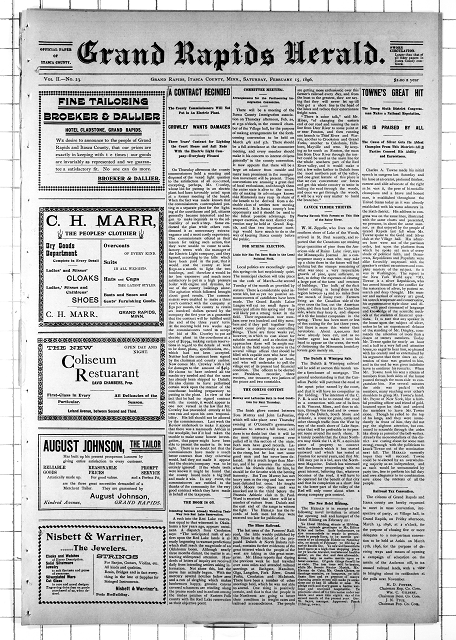Grand Rapids Herald-Review
Iron and lumber review (Grand Rapids, Minn.) 1892-1896 Browse the title
Grand Rapids herald (Grand Rapids, Minn.) 1894-1896 Browse the title
Grand Rapids herald-review (Grand Rapids, Minn.) 1896-1977 Browse the title
Grand Rapids herald-review (Grand Rapids, Minn.) 1978-current Browse the title
Issues published after 1977 can only be accessed from the Gale Family Library at the Minnesota History Center.
Grand Rapids, Minnesota - located in the central-northern portion of the state - was founded as a lumber settlement around 1872, with a population of roughly 100 people. The town lay at the uppermost limit of practical steamboat travel on the Mississippi River, with an easy route to float timber from the surrounding pine forests down to the big city markets. Mining was another attraction for the area, thanks to its proximity to the western edge of the Mesabi Range, rich with mineral deposits. Grand Rapids incorporated in 1891, its population having grown to almost 800 people, and it soon became the seat of Itasca County, which it remains today.
The Iron and Lumber Review was first published in Grand Rapids by Graffam & Orr sometime in 1892. Edited by H.E. Graffam, this weekly Saturday paper typically ran four pages with eight columns. As noted by its motto, “Devoted to the Interests of Itasca County,” the newspaper focused its coverage on local Grand Rapids and Itasca County news, mostly lumber and mining related, but also featured condensed stories from around the country and world. One of the more notable local events captured by the Review was the “first lynching to be recorded against the record of the Mesaba iron range,” of John Domeau, accused of sexual assault May 13, 1893. The paper also covered the fallout from the market crash of 1893. The Review did not begin with an official political bias, but announced in its August 19, 1893, issue that it would represent the interests of the Democratic party to balance out the Republican view of the Grand Rapids Magnet, the other major newspaper in town at the time.
A rival Democratic newspaper, the Grand Rapids Herald, was founded in September 1894 by E.C. Kiley, who served as editor and publisher. The Herald was an eight-page, six-column weekly that focused its coverage on local news, but also covered national and international stories by wire. The Herald argued for Democratic positions, like a turn away from the gold standard to bimetallism and opposition to tariffs, in weekly columns. Editor Kiley was the only Democratic candidate elected as Itasca County judge in 1896, serving a two-year term. Local events of note covered in the Herald include the April 1896 opening of Red Lake Indian Reservation settlement and the “sooners” who tried to get on early, as well as the construction and opening of the Itasca County Courthouse.
In May of 1896 the Grand Rapids Herald bought out and merged with its local competitor Iron Lumber and Review, becoming the Grand Rapids Herald-Review, with E.C. Kiley continuing as editor. The Herald-Review, retaining the Democratic bias of its predecessor titles, became the official newspaper of both Itasca County and Grand Rapids, focusing its coverage on local news but also featuring stories from the rest of the country and world by wire. The paper published weekly on Saturdays until September 1954, when it began semi-weekly publication. Issues for September 13, 1954-August 18, 1980, alternate title between Grand Rapids Herald and Grand Rapids Review. In December of 2011 Grand Rapids was dropped from the masthead, continuing as the Herald-Review. The newspaper has continued its focus on the Grand Rapids and Itasca County area, publishing biweekly on Wednesdays and Sundays. As of 2020 the paper has a circulation base of approximately 9,000 subscribers and is edited by Britta Arendt.
